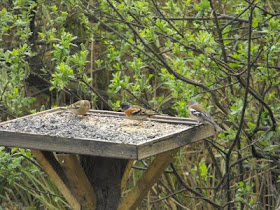16th April 2011
The week before the Easter holidays had got me guessing what my next Norfolk tick would be. The White-tailed Eagle and Black Stork seemed unlikely to stick around, but I had a good feeling about Ring-necked Parakeet (surely one is frequenting gardens in the north-east of the county somewhere?). Anyway, when news came out that a Wood Warbler, the commonest British bird that I was yet to see (having finally got Red Grouse last year) was at Sculthorpe Moor, a favourite reserve of ours, the stage was set for a fourth Phyllosc in three days.
Upon arrival we heard that the Wood Warbler had been seen and heard on a dawn chorus walk earlier that morning, but not heard since. We weren't discouraged, and as we drew near the Frank Jarvis Hide we were met by a birder who had just relocated the bird. We couldn't hear anything, but then the Wood Warbler began calling from woodland across the bridge from Old Gits Corner. It gave good views, flying actively around near the tops of the trees along the boardwalk, calling but not giving full song.
Once the Wood Warbler flew back across the river (and had stopped calling) we carried on to the Whitley Hide, seeing a couple of Orange-tips. Watching the bird table we saw male and female Bullfinches, a pair of Bramblings, male and female Reed Buntings and a Marsh Tit. In the distance my first Cuckoo of the year was calling. On the way back one of the resident plastic Golden Pheasants jumped up into a tree, making a weird squeaky call. A couple of Marsh/Willow Tits on the feeder at Old Gits Corner flew off before I could get a decent look, but we shall undoubtedly be back for another visit soon.



No comments:
Post a Comment